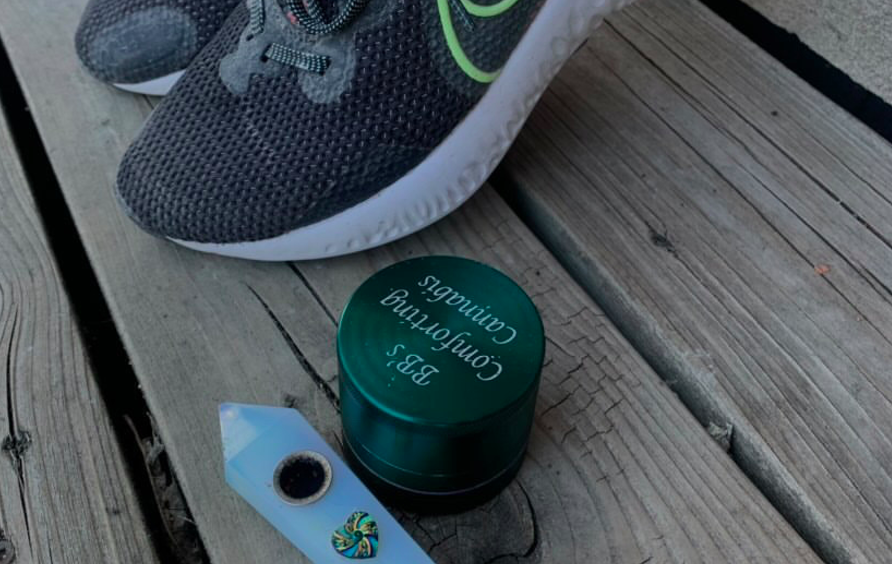Bryanna Arnold puts on her running pants and slips into well-worn shoes for a run along the Rideau Canal, where the trees are blossoming. After tying her laces, she grinds some cannabis, packs the bowl of her crystal pipe and lights up to get in the zone.
As the effects of the weed set in and Arnold takes off, she feels relaxed and light on her feet. The tension she would feel on her knees without the drug disappears and she feels as though she could run forever.
Many think cannabis slows you down, lowers motivation and makes you lazy. But to others it’s a tool for increased self-improvement, enjoyment and motivation.
Using cannabis while exercising has been a growing phenomenon — and it’s slowly gaining recognition for its benefits.
The Canada legalized marijuana in October 2018. Since then, the cannabis industry has expanded into the sport, health and wellness marketplace.
Although there have been few studies examining the benefits, using cannabis while exercising has the potential to enhance performance, pleasure, energy and recovery time. Observers predict this will fuel the industry’s growth in the lifestyle and fitness sector in the coming years, further reducing the stigma that surrounds cannabis.
“We have come so far from where we were four years ago,” said Jessica Dalziel, director of clinical services at the Canada House Clinics, one of the country’s first cannabis clinics.
Making a difference with marijuana
Dalziel said she knew she was making a difference in patients’ lives within three months of opening the clinic.
“I was seeing things I have never seen in pain management with pharmaceuticals,” said Dalziel. “It has been a mind-blowing industry.”
A 2017 online survey conducted by Frontiers in Public Health on cannabis use during exercise among adult users in states that have fully legalized the drug showed that 81.7 per cent of the 605 participants endorsed using cannabis while keeping fit. These people tended to be younger and male. After controlling for other factors, the study showed that people who used cannabis reported engaging in more minutes of exercise each week.
The majority who used cannabis shortly after or before exercise reported that it enhanced their enjoyment of and recovery from exercise, while about half reported it increased motivation to work out.
The effects cannabis can have on a person’s fitness remain uncertain. The Frontiers in Public Health study pointed to reports suggesting endurance athletes should use cannabis during training and that the drug could improve performance in other sports too. This potential has prompted the World Anti-Doping Agency to ban the use of cannabis in most sports until further information is known.
Logan Rogers, a personal trainer, said he’s had a few clients who regularly work out under the influence, but sees no drawbacks if it benefits them.
“Trainers know how to design good programs, but the best program is one that the client can and will follow,” said Rogers. “For some, taking cannabis out of the equation may hinder their chances of returning. So, if they need it so that they will come and train, I’m 100 per cent for that opposed to them not coming at all.”
Shaping up
Alison Becker began using cannabis to alleviate some of the discomfort of getting back in shape. It is now a common part of her fitness routine.
“I merge cannabis with my trail running, hiking and long-distance bike touring — but not all the time,” said Becker, reflecting on the importance of keeping her tolerance low. “When cannabis engages with my movement practice, I feel time and space dissolve. I feel connected, immersed, invincible.”
Although cannabis has many benefits, experts say over-consumption can have negative effects and that those must not be downplayed. They advise knowing your limits and starting with modest goals.
Arnold, a university student and creator of the @comfortingcannabis Instagram page, recommends sitting down, having some water and/or something to eat if over-consumption occurs.
The method that you choose to get high depends on what type of high you want to experience while exercising, said Dalziel. If you are looking for more of a head-driven high to change something in your mindset, she recommends vaporizing dried flower. If you are trying to combat physical pain, she encourages oral consumption as that will provide a fuller body effect.
‘I can’t say that anyone will feel that same effect, but I do not feel my body pain and I feel more energy when I do take it. If I run without it, I’m sore and my ankles hurt after.’
— Jessica Dalziel, director of clinical services, Canada House Clinics
Because cannabis is a natural plant, Dalziel encourages people who are taking any kind of energy-boosting supplement to try it. If you are incapable of exercising because of physical pain, she said she believes it is worth a shot to try cannabis, as well.
Finally, she encourages people who suffer from sports-induced asthma to incorporate pinene — a component in certain cannabis strains that helps with respiration — into their routine.
“There are components in cannabis known as terpenes — and one specifically that I use is called ‘pinene’. It’s a phenomenal bronchodilator, so utilizing this specific component of the plant can help your respiration,” said Dalziel.
A bronchodilator helps open airways. And pinene is also being studied as an anti-inflammatory that could help people with recovery.
Because Dalziel does half-marathons, to eliminate her post-running pain she uses “Delahaze” oil, which is a sativa-based strain of cannabis with high THC and elevated levels of pinene.
“I can’t say that anyone will feel that same effect,” said Dalziel, “but I do not feel my body pain and I feel more energy when I do take it. If I run without it, I’m sore and my ankles hurt after.”
Brad Poulos, an educator and founder of the “cannabis essentials” course series at Ryerson University, said he believes that pain relief through cannabis will attract non-cannabis users to the industry instead of the combination of exercise and cannabis.
More ‘reward’ than tool
Poulos said there’s been progress in finding strains for rapid pain relief, noting that some patients who struggle with arthritis use CBD oil to help manage the pain. He expects such uses to become more common.
To Becker and Arnold, the combination of cannabis and exercise is freeing and relaxing on top of relieving pain. They say it helps them be mindful of how their bodies are moving and how to manage their breathing.
For others, such as Ben Kaplan, general manager of iRun magazine and a freelance journalist who often writes for the National Post, using cannabis with exercise is more of a reward than a tool.
“I don’t personally put the two together like that,” he said. “I have before and I didn’t like it. For me it’s more of a separate thing. I’ll do the work and then I’ll earn that reward.”
But others are getting value from the combination. “It really shows that cannabis can bring more value into people’s lives than some may think,” said Jake Crow, the founder of BudTender, a canna-tech business that was recently sold to an American firm known as SpringBig, where Crow now works.
Eliminating stereotypes
In 2018, Becker and her partner embarked on a cross-Canada cycling trip called The Good Vibes Tour Powered by WeedMaps. The aim was to help eliminate the lazy stereotype about cannabis users and to demonstrate that weed can be part of a healthy and active lifestyle.
The two cycled from Victoria to Halifax with the support of WeedMaps, an online platform that has been called the ‘Yelp’ of the cannabis industry. WeedMaps has made a name for itself in the sports world by supporting athletes on their cannabis and sports journeys as well.
Arnold and Kaplan said they believe using cannabis could become as common and normalized as consuming alcohol is today.
While cannabis advocates look to the future with an open mind, they’re cautious that what works for one person may not work for someone else. But Becker is convinced of the health benefits of cannabis.
“Because of my relationship with cannabis and movement being such a positive influence on my life, I have been able to completely turn my life around,” Becker said. “People who knew me seven years ago sometimes don’t even recognize me today, the change has been that profound.”




